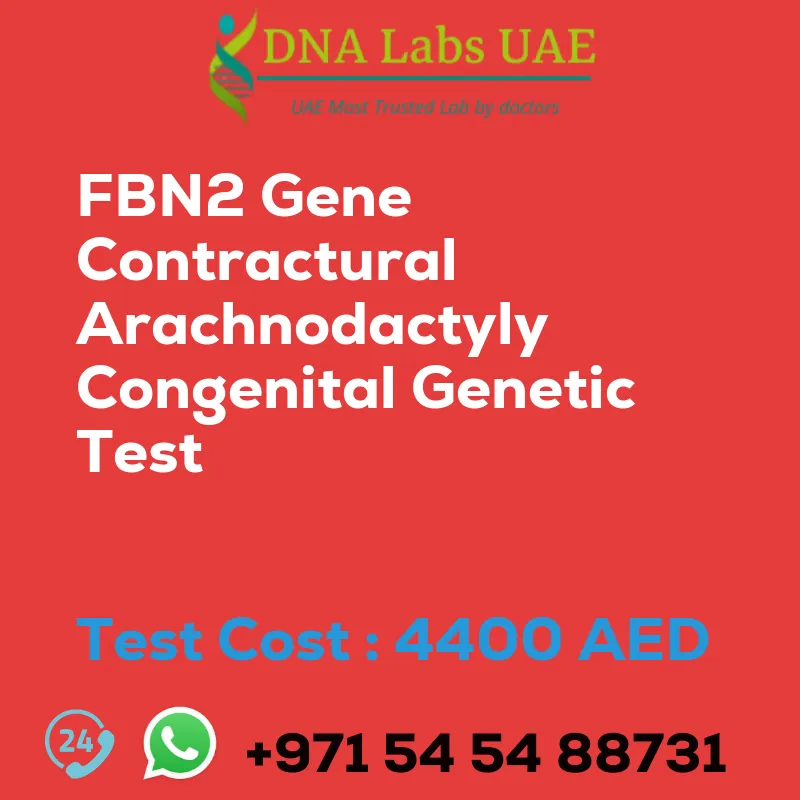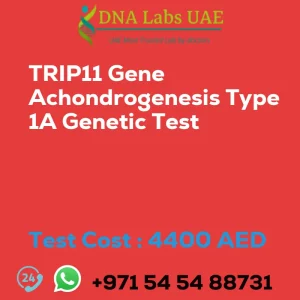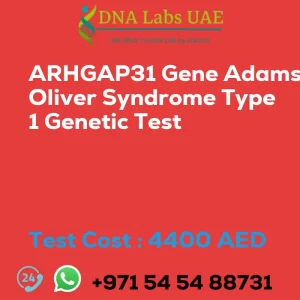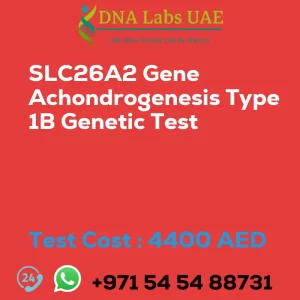FBN2 Gene Contractural Arachnodactyly Congenital Genetic Test
Are you concerned about the possibility of having FBN2 gene contractural arachnodactyly? DNA Labs UAE offers a comprehensive genetic test that can provide you with the answers you need. Our FBN2 gene contractural arachnodactyly congenital genetic test is designed to analyze your DNA and identify any mutations or variations in the FBN2 gene that may be causing the disorder.
Test Details
FBN2 gene contractural arachnodactyly, also known as congenital NGS (Next-Generation Sequencing) genetic test, is a genetic disorder characterized by abnormalities in the FBN2 gene. This gene provides instructions for producing a protein called fibrillin-2, which is important for the structure and function of connective tissues in the body. Individuals with FBN2 gene contractural arachnodactyly typically have long, slender fingers and toes (arachnodactyly), joint contractures (limited range of motion in certain joints), and other skeletal abnormalities. These abnormalities may affect the hands, feet, spine, and other areas of the body. In some cases, individuals may also have additional features such as scoliosis, pectus deformities (abnormalities of the chest wall), and a tall and thin body type.
The congenital NGS genetic test for FBN2 gene contractural arachnodactyly involves analyzing the individual’s DNA to identify any mutations or variations in the FBN2 gene. Next-Generation Sequencing is a high-throughput DNA sequencing technique that allows for the rapid and accurate sequencing of multiple genes simultaneously. This test can help confirm a diagnosis of FBN2 gene contractural arachnodactyly and identify specific mutations in the FBN2 gene that may be causing the disorder.
Test Components
- Price: 4400.0 AED
- Sample Condition: Blood or Extracted DNA or One drop Blood on FTA Card
- Report Delivery: 3 to 4 Weeks
- Method: NGS Technology
- Test Type: Osteology Dermatology Immunology Disorders
- Doctor: Dermatologist
- Test Department: Genetics
Pre Test Information
Before undergoing the FBN2 gene contractural arachnodactyly congenital genetic test, it is important to provide the clinical history of the patient who is going for the test. Additionally, a genetic counseling session will be conducted to draw a pedigree chart of family members affected with FBN2 gene contractural arachnodactyly. This information will help in understanding the inheritance pattern of the disorder and making informed decisions regarding family planning.
Benefits of the Test
The results of the genetic test can provide valuable information for individuals and their families, including information about the inheritance pattern of the disorder and the likelihood of passing it on to future generations. This information can be important for genetic counseling and family planning decisions. It is important to note that while a genetic test can confirm the presence of FBN2 gene contractural arachnodactyly, it may not predict the severity or specific symptoms that an individual will experience. The presentation of the disorder can vary widely among affected individuals, even within the same family. Therefore, additional clinical evaluations and assessments may be necessary to fully understand and manage the condition.
Don’t let uncertainty about your genetic makeup hold you back. Contact DNA Labs UAE today to schedule your FBN2 gene contractural arachnodactyly congenital genetic test and gain the knowledge you need for a healthier future.
| Test Name | FBN2 Gene Contractural arachnodactyly congenital Genetic Test |
|---|---|
| Components | |
| Price | 4400.0 AED |
| Sample Condition | Blood or Extracted DNA or One drop Blood on FTA Card |
| Report Delivery | 3 to 4 Weeks |
| Method | NGS Technology |
| Test type | Osteology Dermatology Immunology Disorders |
| Doctor | Dermatologist |
| Test Department: | Genetics |
| Pre Test Information | Clinical History of Patient who is going for FBN2 Gene Contractural arachnodactyly, congenital NGS Genetic DNA Test. A Genetic Counselling session to draw a pedigree chart of family members affected with FBN2 Gene Contractural arachnodactyly, congenital NGS Genetic DNA Test gene FBN2 |
| Test Details |
FBN2 gene contractural arachnodactyly, also known as congenital NGS (Next-Generation Sequencing) genetic test, is a genetic disorder characterized by abnormalities in the FBN2 gene. This gene provides instructions for producing a protein called fibrillin-2, which is important for the structure and function of connective tissues in the body. Individuals with FBN2 gene contractural arachnodactyly typically have long, slender fingers and toes (arachnodactyly), joint contractures (limited range of motion in certain joints), and other skeletal abnormalities. These abnormalities may affect the hands, feet, spine, and other areas of the body. In some cases, individuals may also have additional features such as scoliosis, pectus deformities (abnormalities of the chest wall), and a tall and thin body type. The congenital NGS genetic test for FBN2 gene contractural arachnodactyly involves analyzing the individual’s DNA to identify any mutations or variations in the FBN2 gene. Next-Generation Sequencing is a high-throughput DNA sequencing technique that allows for the rapid and accurate sequencing of multiple genes simultaneously. This test can help confirm a diagnosis of FBN2 gene contractural arachnodactyly and identify specific mutations in the FBN2 gene that may be causing the disorder. The results of the genetic test can provide valuable information for individuals and their families, including information about the inheritance pattern of the disorder and the likelihood of passing it on to future generations. This information can be important for genetic counseling and family planning decisions. It is important to note that while a genetic test can confirm the presence of FBN2 gene contractural arachnodactyly, it may not predict the severity or specific symptoms that an individual will experience. The presentation of the disorder can vary widely among affected individuals, even within the same family. Therefore, additional clinical evaluations and assessments may be necessary to fully understand and manage the condition. |







